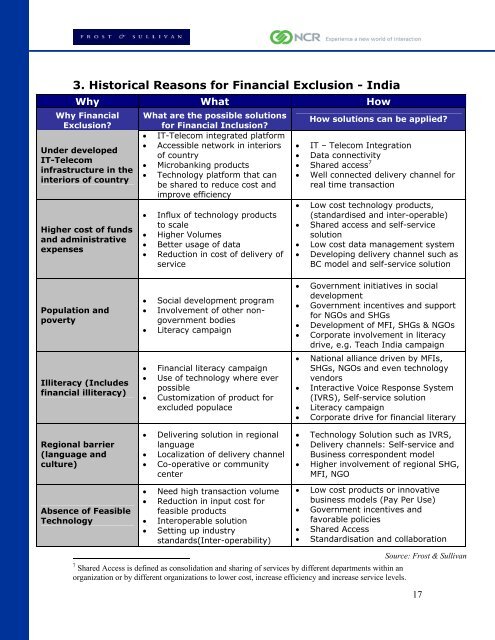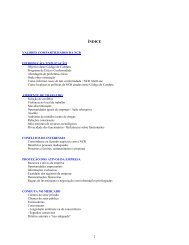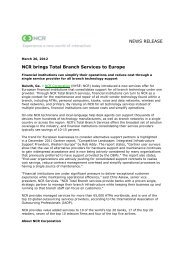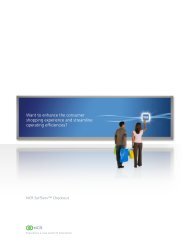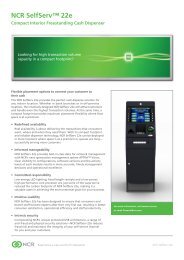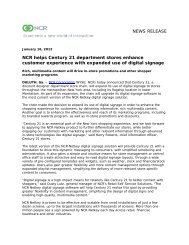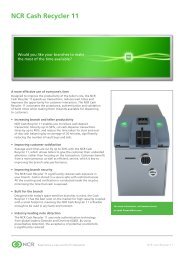Financial Inclusion White Paper - NCR
Financial Inclusion White Paper - NCR
Financial Inclusion White Paper - NCR
Create successful ePaper yourself
Turn your PDF publications into a flip-book with our unique Google optimized e-Paper software.
3. Historical Reasons for <strong>Financial</strong> Exclusion - India<br />
Why What How<br />
Why <strong>Financial</strong><br />
Exclusion?<br />
Under developed<br />
IT-Telecom<br />
infrastructure in the<br />
interiors of country<br />
Higher cost of funds<br />
and administrative<br />
expenses<br />
Population and<br />
poverty<br />
Illiteracy (Includes<br />
financial illiteracy)<br />
Regional barrier<br />
(language and<br />
culture)<br />
Absence of Feasible<br />
Technology<br />
What are the possible solutions<br />
for <strong>Financial</strong> <strong>Inclusion</strong>?<br />
• IT-Telecom integrated platform<br />
• Accessible network in interiors<br />
of country<br />
• Microbanking products<br />
• Technology platform that can<br />
be shared to reduce cost and<br />
improve efficiency<br />
• Influx of technology products<br />
to scale<br />
• Higher Volumes<br />
• Better usage of data<br />
• Reduction in cost of delivery of<br />
service<br />
• Social development program<br />
• Involvement of other non-<br />
government bodies<br />
• Literacy campaign<br />
• <strong>Financial</strong> literacy campaign<br />
• Use of technology where ever<br />
possible<br />
• Customization of product for<br />
excluded populace<br />
• Delivering solution in regional<br />
language<br />
• Localization of delivery channel<br />
• Co-operative or community<br />
center<br />
• Need high transaction volume<br />
• Reduction in input cost for<br />
feasible products<br />
• Interoperable solution<br />
• Setting up industry<br />
standards(Inter-operability)<br />
How solutions can be applied?<br />
• IT – Telecom Integration<br />
• Data connectivity<br />
• Shared access 7<br />
• Well connected delivery channel for<br />
real time transaction<br />
• Low cost technology products,<br />
(standardised and inter-operable)<br />
• Shared access and self-service<br />
solution<br />
• Low cost data management system<br />
• Developing delivery channel such as<br />
BC model and self-service solution<br />
• Government initiatives in social<br />
development<br />
• Government incentives and support<br />
for NGOs and SHGs<br />
• Development of MFI, SHGs & NGOs<br />
• Corporate involvement in literacy<br />
drive, e.g. Teach India campaign<br />
• National alliance driven by MFIs,<br />
SHGs, NGOs and even technology<br />
vendors<br />
• Interactive Voice Response System<br />
(IVRS), Self-service solution<br />
• Literacy campaign<br />
• Corporate drive for financial literary<br />
• Technology Solution such as IVRS,<br />
• Delivery channels: Self-service and<br />
Business correspondent model<br />
• Higher involvement of regional SHG,<br />
MFI, NGO<br />
• Low cost products or innovative<br />
business models (Pay Per Use)<br />
• Government incentives and<br />
favorable policies<br />
• Shared Access<br />
• Standardisation and collaboration<br />
7 Shared Access is defined as consolidation and sharing of services by different departments within an<br />
organization or by different organizations to lower cost, increase efficiency and increase service levels.<br />
Source: Frost & Sullivan<br />
17


